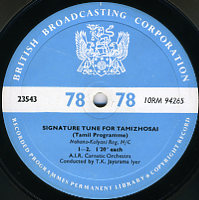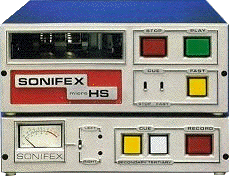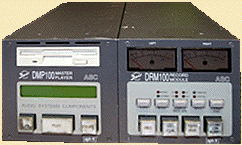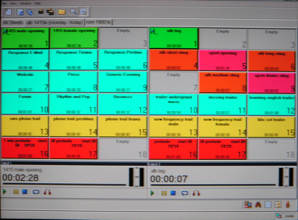

CONTENTS
1 INTRODUCTION
2 STEEL TAPE
3 OPTICAL FILM
4 DIRECTLY-CUT DISKS
5 MAGNETIC TAPE
6 PORTABLE RECORDING
7 CARTS AND DARTS
8 DIGITAL RECORDING AND PLAYOUT
 Although pressed gramophone
records were unsuitable for general use in broadcasting, they did have
a use for long-standing signature tunes. The practise of having a
recognizable piece of music at the beginning and end of a programme had
come into use in the 1930s, and was common by the late 1940s. The
Overseas Service language broadcasts mostly had their own signature
tunes, and 78rpm (and later LP) pressings provided the most convenient
way of providing these. Of course it was always possible to put them on
tape, but this was operationally less convenient.
Although pressed gramophone
records were unsuitable for general use in broadcasting, they did have
a use for long-standing signature tunes. The practise of having a
recognizable piece of music at the beginning and end of a programme had
come into use in the 1930s, and was common by the late 1940s. The
Overseas Service language broadcasts mostly had their own signature
tunes, and 78rpm (and later LP) pressings provided the most convenient
way of providing these. Of course it was always possible to put them on
tape, but this was operationally less convenient.
However by the 1970s the cost of making the pressings, and the difficulty in changing signature tunes, was leading to tape being used: the practice of using 'stings' (short musical phrases used - often over-used - to punctuate a programme) was coming into fashion and was very much less convenient to handle on tape.
American radio stations had already faced this situation, coupled with the need for a single person to be able to present, play records and stings: here tapes would be impossible to operate. The solution was a tape cartridge with standard ¼ inch tape which was fitted in a continuous loop. When a sting was recorded onto it, the machine placed a short burst of tone on a separate cue track, just before the actual recording: on playback, the machine played until it found this tone, stopping so that it was set up ready to go. The cartridge could easily be removed and replaced with another, so that it was quick and easy to select a sting and get it on air.
 These
came into use in the BBC World Service around 1990 (Radios 1 and 2 had
already been using them for some time); the
World Service
was late in getting them because of the sheer size of the operation
(with over 40 studios any change of equipment was bound to be a long
process) - and indeed just as we were installing them I remember we had
a visit from an American broadcaster who told us that his station was
just ripping them out and replacing them with digital versions.
These
came into use in the BBC World Service around 1990 (Radios 1 and 2 had
already been using them for some time); the
World Service
was late in getting them because of the sheer size of the operation
(with over 40 studios any change of equipment was bound to be a long
process) - and indeed just as we were installing them I remember we had
a visit from an American broadcaster who told us that his station was
just ripping them out and replacing them with digital versions.
On the whole the cartridge - or 'cart' - format served us well. They were reliable - the only problem was that as the tape wore out there was a tendency for the machine to miss the tone and go right round again. The intention of their original design was that each cart would contain only one sting: a number of producers went for carts with several stings in succession with the intention of reducing the number of changeovers. However, with this it was impossible to tell where you were, and if you played the cart to check it and found it was the item you wanted, you had to step round all the others - counting them carefully - and work back to the correct one. As you can imagine, this led to the wrong sting being played on many occasions.
 The
replacement method, installed several years
later, got round all these problems. The ASC digital cart - rapidly
abbreviated to 'dart' - used standard high-density floppy disks, then
standard in all computers. They used a proprietary format (so they had
to be formatted in the machine) and could record a moderate length of
audio. More than one track could be recorded: the tracks could be
titled, so that though you still had to step through them you could see
what you were doing, and you didn't have to wait while it spooled
through. This method was a vast operational improvement on the old
carts, and was widely used not only for signature tunes and stings but
also short inserts into programmes, such as excerpts from politicians'
speeches, or other 'actuality'.
The
replacement method, installed several years
later, got round all these problems. The ASC digital cart - rapidly
abbreviated to 'dart' - used standard high-density floppy disks, then
standard in all computers. They used a proprietary format (so they had
to be formatted in the machine) and could record a moderate length of
audio. More than one track could be recorded: the tracks could be
titled, so that though you still had to step through them you could see
what you were doing, and you didn't have to wait while it spooled
through. This method was a vast operational improvement on the old
carts, and was widely used not only for signature tunes and stings but
also short inserts into programmes, such as excerpts from politicians'
speeches, or other 'actuality'.
 These
worked well for us, but the next step turned out to be ill-advised. The
machines stayed the same, but the disk-reading mechanism was changed to
accomodate 'Zip' cartridges. These were invented by Iomega and intended
to replace the 1.4MB floppy disk with more storage (in the days when
100MB seemed an awful lot of space). They would therefore store a lot
more
audio, and the operation was the same (though loading was slightly
slower). However, Iomega had designed the format for moderate
domestic use, not for the heavy duty required in broadcasting, and
after a time the mechanisms and the cartridges started to give
problems. Because of the usual delay in equipping the World Service
spares became difficult to get, and we were stuck with them until the
availability of proper digital systems.
These
worked well for us, but the next step turned out to be ill-advised. The
machines stayed the same, but the disk-reading mechanism was changed to
accomodate 'Zip' cartridges. These were invented by Iomega and intended
to replace the 1.4MB floppy disk with more storage (in the days when
100MB seemed an awful lot of space). They would therefore store a lot
more
audio, and the operation was the same (though loading was slightly
slower). However, Iomega had designed the format for moderate
domestic use, not for the heavy duty required in broadcasting, and
after a time the mechanisms and the cartridges started to give
problems. Because of the usual delay in equipping the World Service
spares became difficult to get, and we were stuck with them until the
availability of proper digital systems.
 Digital systems will
be examined on the next page: the
specific
issue of stings was addressed by the 'Cartwall' section of RadioMan.
Here all the stings for a programme could be loaded onto a screen
(left) and accessed immediately either using a mouse in the traditional
way or with a custom keypad: just hit the correct key and the sting
would play. The selection of stings could be saved to be brought up
whenever required, and it was straightforward to add new ones as
necessary.
Digital systems will
be examined on the next page: the
specific
issue of stings was addressed by the 'Cartwall' section of RadioMan.
Here all the stings for a programme could be loaded onto a screen
(left) and accessed immediately either using a mouse in the traditional
way or with a custom keypad: just hit the correct key and the sting
would play. The selection of stings could be saved to be brought up
whenever required, and it was straightforward to add new ones as
necessary.
The development of digital recording and playout will be examined in the final page.
1 INTRODUCTION
2 STEEL TAPE
3 OPTICAL FILM
4 DIRECTLY-CUT DISKS
5 MAGNETIC TAPE
6 PORTABLE RECORDING
7 CARTS AND DARTS
8 DIGITAL RECORDING AND PLAYOUT

 Although pressed gramophone
records were unsuitable for general use in broadcasting, they did have
a use for long-standing signature tunes. The practise of having a
recognizable piece of music at the beginning and end of a programme had
come into use in the 1930s, and was common by the late 1940s. The
Overseas Service language broadcasts mostly had their own signature
tunes, and 78rpm (and later LP) pressings provided the most convenient
way of providing these. Of course it was always possible to put them on
tape, but this was operationally less convenient.
Although pressed gramophone
records were unsuitable for general use in broadcasting, they did have
a use for long-standing signature tunes. The practise of having a
recognizable piece of music at the beginning and end of a programme had
come into use in the 1930s, and was common by the late 1940s. The
Overseas Service language broadcasts mostly had their own signature
tunes, and 78rpm (and later LP) pressings provided the most convenient
way of providing these. Of course it was always possible to put them on
tape, but this was operationally less convenient.However by the 1970s the cost of making the pressings, and the difficulty in changing signature tunes, was leading to tape being used: the practice of using 'stings' (short musical phrases used - often over-used - to punctuate a programme) was coming into fashion and was very much less convenient to handle on tape.
American radio stations had already faced this situation, coupled with the need for a single person to be able to present, play records and stings: here tapes would be impossible to operate. The solution was a tape cartridge with standard ¼ inch tape which was fitted in a continuous loop. When a sting was recorded onto it, the machine placed a short burst of tone on a separate cue track, just before the actual recording: on playback, the machine played until it found this tone, stopping so that it was set up ready to go. The cartridge could easily be removed and replaced with another, so that it was quick and easy to select a sting and get it on air.
 These
came into use in the BBC World Service around 1990 (Radios 1 and 2 had
already been using them for some time); the
World Service
was late in getting them because of the sheer size of the operation
(with over 40 studios any change of equipment was bound to be a long
process) - and indeed just as we were installing them I remember we had
a visit from an American broadcaster who told us that his station was
just ripping them out and replacing them with digital versions.
These
came into use in the BBC World Service around 1990 (Radios 1 and 2 had
already been using them for some time); the
World Service
was late in getting them because of the sheer size of the operation
(with over 40 studios any change of equipment was bound to be a long
process) - and indeed just as we were installing them I remember we had
a visit from an American broadcaster who told us that his station was
just ripping them out and replacing them with digital versions.On the whole the cartridge - or 'cart' - format served us well. They were reliable - the only problem was that as the tape wore out there was a tendency for the machine to miss the tone and go right round again. The intention of their original design was that each cart would contain only one sting: a number of producers went for carts with several stings in succession with the intention of reducing the number of changeovers. However, with this it was impossible to tell where you were, and if you played the cart to check it and found it was the item you wanted, you had to step round all the others - counting them carefully - and work back to the correct one. As you can imagine, this led to the wrong sting being played on many occasions.
 The
replacement method, installed several years
later, got round all these problems. The ASC digital cart - rapidly
abbreviated to 'dart' - used standard high-density floppy disks, then
standard in all computers. They used a proprietary format (so they had
to be formatted in the machine) and could record a moderate length of
audio. More than one track could be recorded: the tracks could be
titled, so that though you still had to step through them you could see
what you were doing, and you didn't have to wait while it spooled
through. This method was a vast operational improvement on the old
carts, and was widely used not only for signature tunes and stings but
also short inserts into programmes, such as excerpts from politicians'
speeches, or other 'actuality'.
The
replacement method, installed several years
later, got round all these problems. The ASC digital cart - rapidly
abbreviated to 'dart' - used standard high-density floppy disks, then
standard in all computers. They used a proprietary format (so they had
to be formatted in the machine) and could record a moderate length of
audio. More than one track could be recorded: the tracks could be
titled, so that though you still had to step through them you could see
what you were doing, and you didn't have to wait while it spooled
through. This method was a vast operational improvement on the old
carts, and was widely used not only for signature tunes and stings but
also short inserts into programmes, such as excerpts from politicians'
speeches, or other 'actuality'. These
worked well for us, but the next step turned out to be ill-advised. The
machines stayed the same, but the disk-reading mechanism was changed to
accomodate 'Zip' cartridges. These were invented by Iomega and intended
to replace the 1.4MB floppy disk with more storage (in the days when
100MB seemed an awful lot of space). They would therefore store a lot
more
audio, and the operation was the same (though loading was slightly
slower). However, Iomega had designed the format for moderate
domestic use, not for the heavy duty required in broadcasting, and
after a time the mechanisms and the cartridges started to give
problems. Because of the usual delay in equipping the World Service
spares became difficult to get, and we were stuck with them until the
availability of proper digital systems.
These
worked well for us, but the next step turned out to be ill-advised. The
machines stayed the same, but the disk-reading mechanism was changed to
accomodate 'Zip' cartridges. These were invented by Iomega and intended
to replace the 1.4MB floppy disk with more storage (in the days when
100MB seemed an awful lot of space). They would therefore store a lot
more
audio, and the operation was the same (though loading was slightly
slower). However, Iomega had designed the format for moderate
domestic use, not for the heavy duty required in broadcasting, and
after a time the mechanisms and the cartridges started to give
problems. Because of the usual delay in equipping the World Service
spares became difficult to get, and we were stuck with them until the
availability of proper digital systems. Digital systems will
be examined on the next page: the
specific
issue of stings was addressed by the 'Cartwall' section of RadioMan.
Here all the stings for a programme could be loaded onto a screen
(left) and accessed immediately either using a mouse in the traditional
way or with a custom keypad: just hit the correct key and the sting
would play. The selection of stings could be saved to be brought up
whenever required, and it was straightforward to add new ones as
necessary.
Digital systems will
be examined on the next page: the
specific
issue of stings was addressed by the 'Cartwall' section of RadioMan.
Here all the stings for a programme could be loaded onto a screen
(left) and accessed immediately either using a mouse in the traditional
way or with a custom keypad: just hit the correct key and the sting
would play. The selection of stings could be saved to be brought up
whenever required, and it was straightforward to add new ones as
necessary.The development of digital recording and playout will be examined in the final page.



